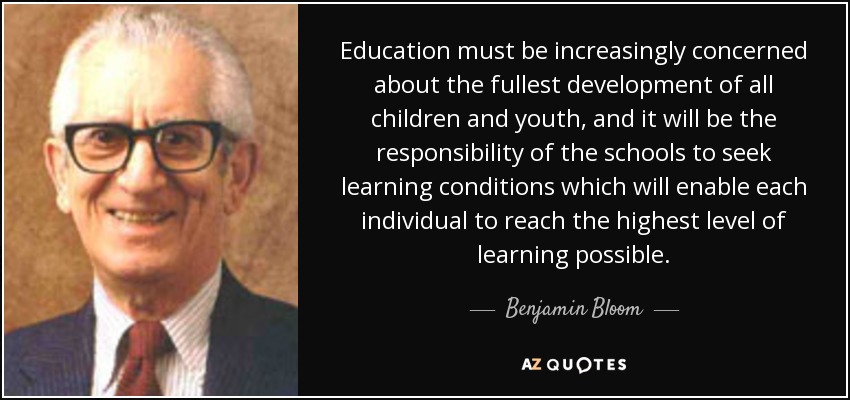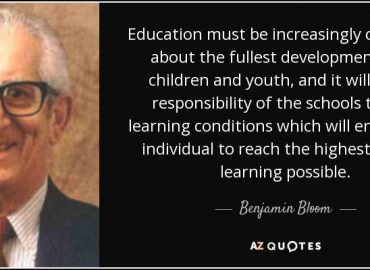LOTS & HOTS in our learning process to Mastery
LOTS & HOTS will lead us -and hence our students- to Mastery. This post was first published on 14th September 2015. The links were then updated in November 2020 and again, in October 2025, to ensure that everything is working and update whatever may be needed.
Poppies Foundation 123-III-Teaching-Principles-Approaches deals with Methodology, teaching principles based on Learning (and acquisition) theories, etc.
One of the issues we cover is how teachers should plan and approach their teaching practice, based on how we learn, in general, and how we learn a language other than our mother tongue, in particular. To study this topic, among other documents and resources, we are using Bloom’s taxonomy. And I was wondering whether you all know the answer to the following questions:
- Who was Bloom?
- What’s Mastery Learning?
- What’s “LOTS & HOTS” and how can we use them to design activities?
Benjamin Bloom
An American educational and cognitive psychologist, Benjamin Bloom lived from almost the beginning (1913) to the end (1999) of the 20th century. Apart from having a Bachelor’s, Master’s and a Ph. D. in Education, he was also an educational adviser to the government of various countries and is considered a guru in education.
He believed that the role of education is to focus on achieving the objectives set rather than on covering material over a given period of time, with no thought for who and how many students are able to grasp the material covered. This is something the Education Authorities of any country willing to offer quality education should always have in mind.
Students, therefore, need to be helped to achieve those goals, and teachers need to design tasks which progressively help ALL STUDENTS TO REACH THOSE GOALS.
He also argued that Education is not a race but a process, and the educator’s role or mission is to create or arrange the right environmental conditions to help ALL students realise their capabilities and achieve the goals set.
Mastery Learning
If Education is a process, so is Learning, and one which takes place from the moment we are born until the moment we die. Unless we suffer from some cognitive disease, of course. That’s one of the features of being human.
As Thomas Guskey points out in his article on Mastery Learning, its foundations can be traced back to Comenius and other educationalists, when they advocated for meaningful learning. It also draws on both cognitivism and behaviourism.
As mentioned above, the idea behind it is that
- There are different stages in the learning process until we reach mastery.
- Each stage in the process is essential and helps us move on to the next.
- Every student can reach mastery provided they are in the right environment and are allowed to progress at their own pace.
LOTS & HOTS
In the learning process to the mastery of something, there are different stages. These stages are part of what is known as Bloom’s taxonomy, which has been revised and can be used as a guide to design activities based on the objectives we aim to achieve.
In a nutshell:
Lower Order Thinking Skills (LOTS) include the stages of remembering or recalling, understanding and applying.
&
Higher Order Thinking Skills (HOTS) include the stages of analysing, evaluating, and creating.
Our task, as teachers and educators, is to design activities and tasks which help our students
- Remember. To do so, the activities may involve listing, naming, labelling, identifying, recognising, etc., words, lexical chunks, appropriate structures, etc.
- Understand. These activities will require describing or explaining what words or lexical chunks mean, paraphrasing with structures or lexis that express the same idea, giving original examples, showing understanding of texts, audios, videos, etc. that use the language covered, etc.
- Apply. Activities such as demonstrating and showing appropriate understanding by using the appropriate term in sentences, texts or dialogues; using appropriate language in a given situation, etc.
- Analyse. In this case, the activities will be related to classifying the information provided in a text or given situation according to specific criteria; analysing the best solution, or the pros and cons; summarising the key contents, etc.
- Evaluate, through activities such as assessing the information provided in a given situation, providing support or criticising the proposals, discussing possible solutions to a problem, etc.
- Create, with activities like writing a report, letter, proposal, script, dialogue, etc., on the topic covered; creating a poster or a presentation following certain requirements, etc.
- Evaluate, through activities such as assessing the information provided in a given situation, providing support or criticising the proposals, discussing possible solutions to a problem, etc.
- Analyse. In this case, the activities will be related to classifying the information provided in a text or given situation according to specific criteria; analysing the best solution, or the pros and cons; summarising the key contents, etc.
- Apply. Activities such as demonstrating and showing appropriate understanding by using the appropriate term in sentences, texts or dialogues; using appropriate language in a given situation, etc.
- Understand. These activities will require describing or explaining what words or lexical chunks mean, paraphrasing with structures or lexis that express the same idea, giving original examples, showing understanding of texts, audios, videos, etc. that use the language covered, etc.
Our aim as teachers is to help students master the language they are learning for their specific needs, and can apply it in the real situations they encounter.
Remember that knowledge is not innate. To be able to use language in the situations we require it for, we need to practise. And to practise with the language we know so that it is properly internalised, we have to experiment with it. That is, we need to make mistakes and see why we made them. In short: Give your students extensive and constant opportunities to experiment with the language, in different places, contexts and situations.
Mistakes help us to learn. Provide your students with plenty of opportunities and situations in which they use the language and make mistakes!







No Comments